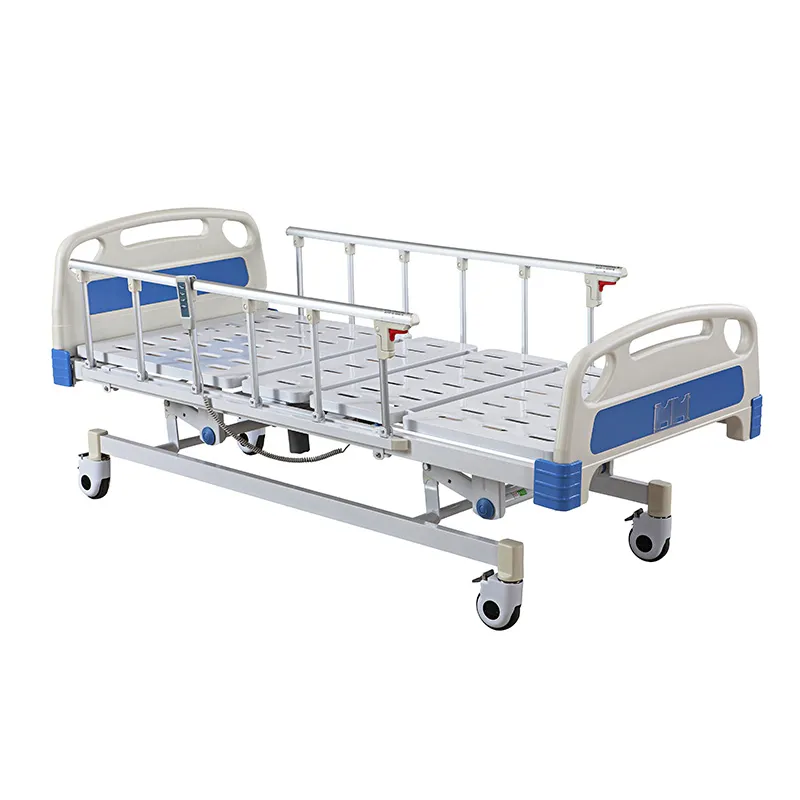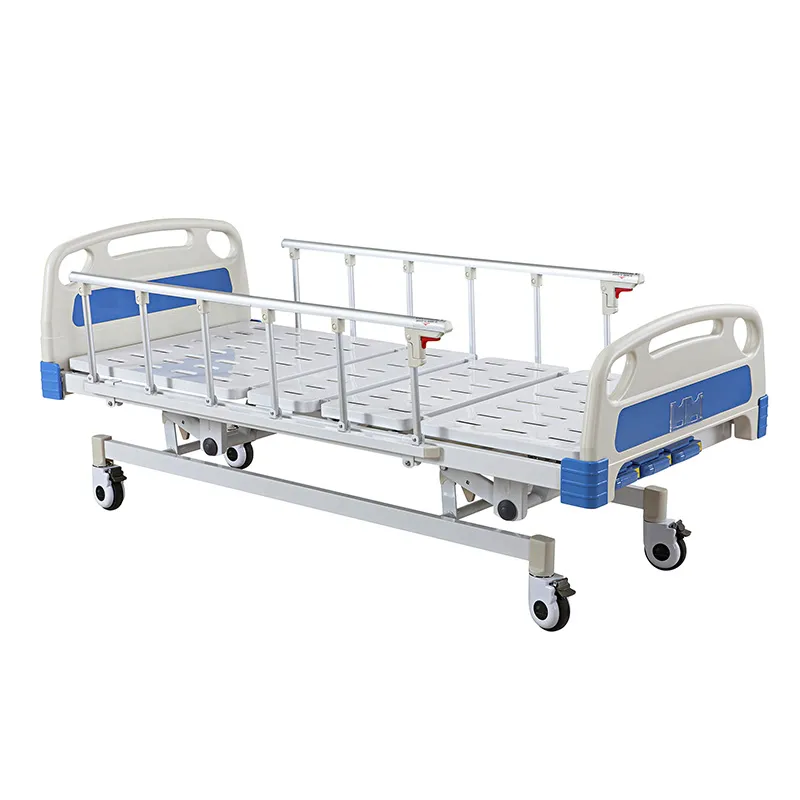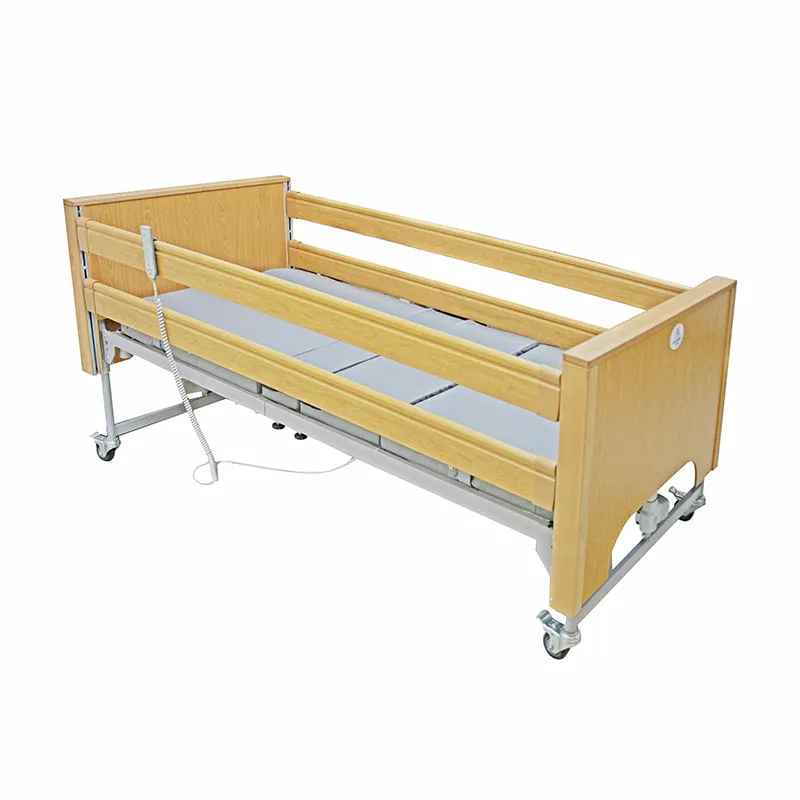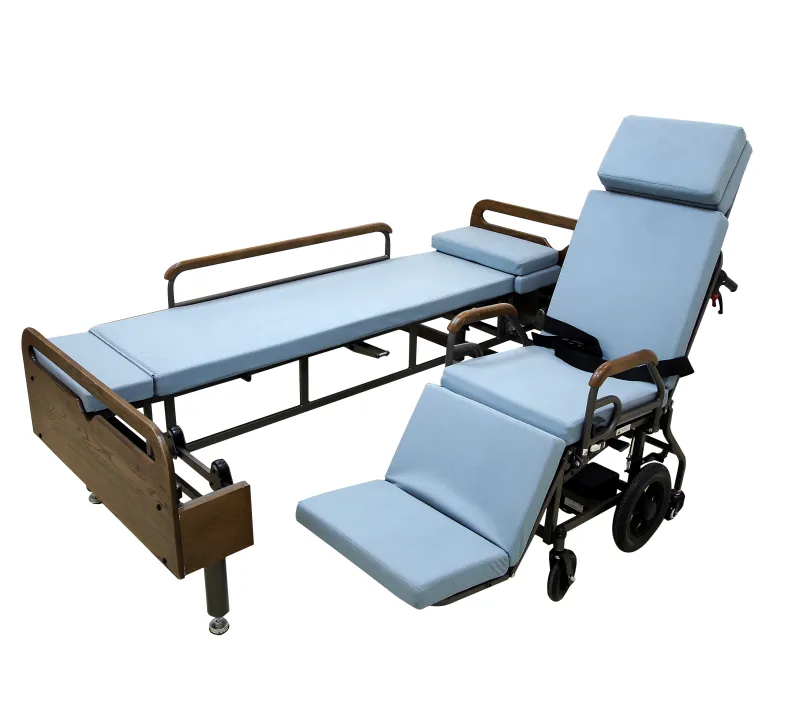
How Many Types of Hospital Beds Are There?
2024-09-12 15:30

In a hospital, a hospital bed may be one of the least noticeable equipment, but it is actually one of the most important parts of patient care. Whether in the emergency room, general ward or intensive care unit, hospital beds play a vital role in the medical process. Different types of hospital beds not only affect the comfort of patients, but also directly affect the effectiveness of care and medical outcomes.
Today, we will explore in detail the different types of hospital beds and their role in medical treatment.
What Is A Hospital Bed?
A hospital bed is a bed designed specifically for medical purposes. It is not only a place for patients to rest, but also a platform for medical operations. Unlike ordinary home beds, hospital beds usually have adjustable features, which can facilitate medical staff to make various adjustments according to the needs of patients, such as changing the height, inclination, and support angle of the back and legs of the bed. In addition, hospital beds are also equipped with various accessories, such as bed rails, infusion stands, mattresses, etc., to meet the medical needs of different patients.
How Many Types of Hospital Beds Are There?
According to the different operation methods and functions, hospital beds are mainly divided into the following types: manual beds, semi-electric beds and fully electric beds. Each type of hospital bed has its own unique Pros and applicable scenarios.
● Manual hospital bed: The height and angle of the bed are adjusted manually.
● Semi-electric hospital bed: It combines manual and electric operation methods. Usually the electric part is used to adjust the back and legs, and the manual part is used to adjust the overall height.
● Fully electric hospital bed: All adjustments are controlled electrically, which is easy to operate and highly accurate. It is suitable for occasions where patients have limited mobility or need to adjust their posture frequently.
Next, we will explore the characteristics, uses, and Pros and Cons of each type of hospital bed in depth.
What Is A Manual Hospital Bed?
A manual hospital bed is the most basic type of hospital bed, and all adjustment functions are achieved through a hand-cranked device. The design of a manual hospital bed is usually simple, mainly consisting of a metal frame, a mattress support surface, and several hand-cranked devices. These hand-cranked devices are usually installed at the foot or side of the bed, and the caregiver or patient can adjust the height or tilt angle of the bed by shaking the handle.
Pros of manual hospital beds:
● Lower price: Since no electric parts are required, manual hospital beds are usually cheaper than electric hospital beds, suitable for medical institutions or families with limited budgets.
● Simple operation: Although manual operation is required, manual beds have a simple structure, the operation process is easy to master, and it is not prone to malfunction.
Cons of Manual Beds:
● Inconvenient for frequent adjustment: For patients who need to adjust their posture or height frequently, manual beds may not be convenient enough because each adjustment requires manual operation.
● Physical requirements for nursing staff: If the bed needs to be adjusted frequently, nursing staff may need to spend more physical strength to operate the hand-cranked device.
Manual beds are usually suitable for patients in the recovery period or occasions with low nursing needs.

What Are Semi-Electric Hospital Beds?
Semi-electric hospital beds combine manual and electric operation methods. Usually, the adjustment of the back and legs is controlled by electric motors, while the overall height adjustment still needs to be done manually. The purpose of this design is to reduce costs and energy consumption while maintaining high operational convenience.
Pros of Semi-Electric Hospital Beds:
● Relatively convenient operation: Compared with manual hospital beds, semi-electric hospital beds are more convenient in adjusting the back and legs, especially for patients who need to adjust their posture frequently.
● Relatively low cost: Although more expensive than manual hospital beds, semi-electric hospital beds are still cheaper than fully electric hospital beds and are a cost-effective choice.
● Energy saving: Since only some functions rely on electricity, semi-electric hospital beds consume less power during use.
Cons of Semi-Electric Hospital Beds:
● Inconvenient height adjustment: Since the overall height still needs to be adjusted manually, it may not be as convenient as fully electric hospital beds for patients who need to adjust the bed height frequently.
● Complex operation: Compared with manual hospital beds, semi-electric hospital beds are slightly more complex to operate, requiring users to master the combination of electric and manual operations.
Semi-electric hospital beds are suitable for medical institutions or families that require a certain degree of electric adjustment and want to control the budget.
What Are Fully Electric Hospital Beds?
Fully electric hospital beds are "high-end products" among hospital beds in hospitals. All adjustment functions are achieved through electric control, including bed height, back angle, leg angle, etc. Usually, hospital beds are equipped with a remote control or control panel, so patients or caregivers can easily adjust various parts of hospital beds to achieve the best comfort and care effect.
Pros of All-Electric Hospital Beds:
● Easy to operate: All adjustments are electrically controlled, and patients or caregivers can complete the adjustment by simply pressing a button, which is very suitable for situations where patients have limited mobility or need to adjust their posture frequently.
● High precision: Electric hospital beds have high adjustment precision and can be precisely adjusted to a specific angle and height according to the needs of patients to provide the most comfortable support.
● Versatility: All-electric hospital beds are usually equipped with a variety of additional functions, such as built-in scales, mattress pressure adjustment, etc., to meet the special needs of different patients.
Cons of All-Electric Hospital Beds:
● Higher price: Due to the configuration of electric control and multiple functions, the price of all-electric hospital beds is usually higher, which is suitable for medical institutions or families with a more generous budget.
● Dependence on electricity: All-electric hospital beds rely on electricity. If there is a power outage or power failure, it may not be adjusted, so it is usually necessary to be equipped with a backup power supply.
All-electric hospital beds are suitable for patients in intensive care units, postoperative recovery units, or with special care needs.
What Are Bariatric Beds Used for?
Bariatric beds are designed specifically for heavier patients and can withstand higher weights, typically 600 to 1,000 pounds or more. In addition to the increased weight, bariatric beds are also wider and longer than ordinary beds to provide better comfort and support.
Main Uses of Bariatric Beds:
● Care for overweight patients: Bariatric beds provide a safe and comfortable resting environment for overweight patients, reducing the risk of mattress deformation or bed damage.
● Postoperative rehabilitation care: For heavier patients, postoperative rehabilitation requires more nursing space and support, and bariatric beds can provide additional support.
● Reduce the physical burden of caregivers: Because the bed is wider and more stable, caregivers can be more relaxed when helping patients move or adjust their posture.
What Are Low Beds Used for?
A low bed is a specially designed hospital bed that can be adjusted to a very low level, usually only a few inches from the ground. The purpose of this design is to reduce the risk of patients falling from the bed, especially for patients who are at risk of falling, such as the elderly or patients with limited mobility.
The Main Uses of Low Beds:
● Preventing falls: The design of low beds makes it so that even if a patient falls from the bed, the height of the fall is very low, thereby reducing the possibility of injury.
● Convenient access for patients: The height of the bed can be adjusted to a very low position, making it easier for patients to get in and out of bed, reducing their dependence on caregivers.
● Suitable for home care: Low beds are not only suitable for hospital use, but also very suitable for home care, especially for patients who need to stay in bed for a long time.
What Is A Pediatric Bed Used for?
Pediatric beds are designed specifically for pediatric patients and usually have smaller sizes and more safety devices, such as higher bed rails, anti-pinch designs, etc., to ensure the safety of pediatric patients.
The Main Uses of Pediatric Beds:
● Care for children: Pediatric beds provide a care environment suitable for children's height and body shape, increasing the comfort and safety of children.
● Reduce the fear of children: Some pediatric beds are also equipped with brightly colored bed rails or cartoon decorations to reduce the fear of children in the hospital environment.
● Provide special care functions: For children who need to stay in bed for a long time, pediatric beds are usually equipped with anti-bedsore mattresses, adjustable bed rails and other functions to provide comprehensive care support.

What Is the Delivery Bed Used for?
The delivery bed is specially designed for delivery and can meet the needs of mothers at different stages of delivery. Delivery beds usually have functions such as adjustable height, tiltable bed, and adjustable leg support so that doctors and midwives can smoothly perform delivery operations.
The Main Uses of Delivery Beds:
● Support during delivery: The delivery bed provides a safe and comfortable delivery environment for mothers, making it easier for doctors to perform delivery operations, such as caesarean section or natural delivery.
● Convenient operation for nursing staff: The multifunctional adjustment design of the delivery bed allows nursing staff to quickly adjust the angle and height of the bed according to the different stages of delivery, which improves work efficiency.
● Postpartum recovery support: The delivery bed is also equipped with postpartum recovery functions, such as mattress adjustment, bed heating, etc., to help mothers recover faster.
What Is the Intensive Care Bed Used for?
The intensive care bed (ICU Bed) is designed for the intensive care unit (ICU) and has comprehensive monitoring and nursing functions. This type of bed is usually equipped with interfaces for a variety of monitoring equipment, which can monitor the patient's vital signs in real time, such as heart rate, blood pressure, respiration, etc.
The Main Uses of Intensive Care Beds:
● Real-time monitoring: The intensive care bed is connected to various monitoring equipment, which can monitor the patient's health status in real time and transmit data to the monitoring system, so that doctors and nursing staff can understand the patient's condition in time.
● Multifunctional adjustment: The intensive care bed has a fully electric adjustment function, which can quickly adjust the angle and position of the bed to meet the needs of different treatments and care.
● Support rescue operation: The design of ICU bed takes into account the need of rescue operation. The bed can be quickly adjusted to the most suitable rescue posture and cooperate with the use of rescue equipment.
What Is the Use of Isolation Bed?
Isolation bed is used for patients with infectious diseases or patients with impaired immune system. It can effectively isolate patients from the outside world and reduce the risk of infection transmission. Isolation beds are usually equipped with special bed curtains or sealing covers and connected to air purification systems to keep the air around the bed clean.
Main Uses of Isolation Beds:
● Infectious disease isolation: Isolation beds are specially designed to prevent the spread of pathogens from infectious patients and protect the safety of other patients and medical staff.
● Protection of patients with impaired immune systems: For patients with weak immune systems, such as cancer patients undergoing chemotherapy, isolation beds can provide a sterile environment to prevent external infection.
● Air purification function: Isolation beds are equipped with air purification systems that can filter microorganisms and particulate matter in the air to keep the air around the bed clean.

Conclusion
| Type of Hospital Bed | Description | Related Concepts |
| Manual bed | Raised and lowered manually by a crank or a hand-held control. | Crank, hand-held control, manual labor |
| Electric bed | Raised and lowered using an electric motor. Can also be adjusted to different positions. | Electric motor, remote control, electronic equipment |
| Bariatric bed | Designed for patients who are overweight or obese. Wider and sturdier than a standard bed. | Overweight, obesity, patient size |
| Low bed | Designed for patients at risk of falling out of bed. Lower to the ground than a standard bed. | Patient falls, bed height |
| Pediatric bed | Designed for children. Smaller in size than a standard bed. | Pediatrics, child-sized equipment |
| Birthing bed | Used during childbirth. Equipped with features such as stirrups and a headrest. | Childbirth, stirrups, headrest, obstetrics |
| Intensive care bed | Used in the intensive care unit. Equipped with features such as a bed rail, an IV pole, and a headrest. | Intensive care unit, bed rail, IV pole, headrest, medical equipment |
| Isolation bed | Used for patients in isolation due to an infectious disease. May have a privacy curtain and a built-in sink. | Infectious disease, isolation, privacy curtain, built-in sink, infection control |
Although there are many types of hospital beds, each one is designed for specific medical needs and aims to provide patients with the best care experience. From manual beds to fully electric beds, from bariatric beds to isolation beds, each bed has its own unique features and uses.
In a healthcare setting, choosing the right bed can not only improve the efficiency of care, but also significantly improve patient comfort and safety. By understanding the types and uses of these beds, healthcare facilities and family caregivers can better support and care for their patients.








